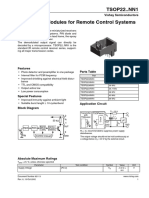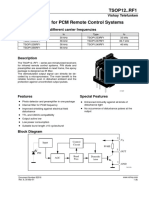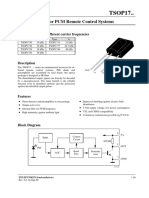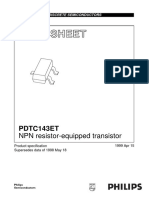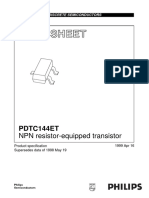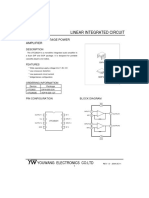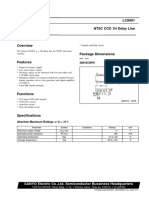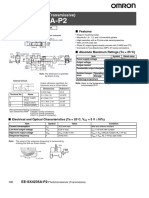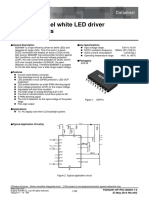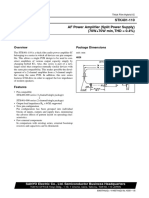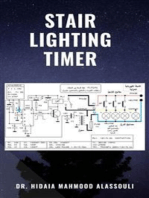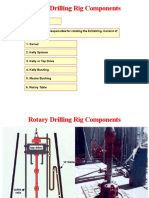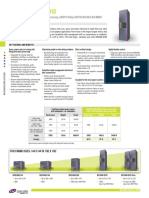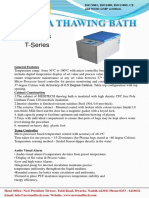TSOP44..QJ1: IR Receiver Modules For Remote Control Systems
TSOP44..QJ1: IR Receiver Modules For Remote Control Systems
Uploaded by
Ĵames-Ĕddìne BaîaCopyright:
Available Formats
TSOP44..QJ1: IR Receiver Modules For Remote Control Systems
TSOP44..QJ1: IR Receiver Modules For Remote Control Systems
Uploaded by
Ĵames-Ĕddìne BaîaOriginal Title
Copyright
Available Formats
Share this document
Did you find this document useful?
Is this content inappropriate?
Copyright:
Available Formats
TSOP44..QJ1: IR Receiver Modules For Remote Control Systems
TSOP44..QJ1: IR Receiver Modules For Remote Control Systems
Uploaded by
Ĵames-Ĕddìne BaîaCopyright:
Available Formats
VISHAY
TSOP44..QJ1
Vishay Semiconductors
IR Receiver Modules for Remote Control Systems
Description
The TSOP44..QJ1 - series are miniaturized receivers
for infrared remote control systems. PIN diode and
preamplifier are assembled on lead frame, the epoxy
package is designed as IR filter.
The demodulated output signal can directly be
decoded by a microprocessor. The main benefit is the
reliable function even in disturbed ambient and the
protection against uncontrolled output pulses.
1
2 16652
3
Features
• Photo detector and preamplifier in one package
• Internal filter for PCM frequency
• Improved shielding against electrical field
disturbance
• TTL and CMOS compatibility
• Output active low
Parts Table
• Low power consumption
Part Carrier Frequency
TSOP4430QJ1 30 kHz
Special Features
TSOP4433QJ1 33 kHz
• Improved immunity against ambient light
TSOP4436QJ1 36 kHz
• Suitable burst length ≥ 10 cycles/burst
TSOP4437QJ1 36.7 kHz
TSOP4438QJ1 38 kHz
Mechanical Data
TSOP4440QJ1 40 kHz
Pinning:
TSOP4456QJ1 56 kHz
1 = OUT, 2 = GND, 3 = VS
Block Diagram
Application Circuit
16833
3
VS
30 kΩ 16842
R1 = 100 Ω
1 Transmitter TSOPxxxx
with VS +VS
Band Demo- OUT TSALxxxx C1 =
Input AGC
Circuit
Pass dulator 4.7 µF
µC
2 OUT
VO
PIN GND GND
Control Circuit GND
R1 + C1 recommended to suppress power supply
disturbances.
The output voltage should not be hold continuously at
a voltage below VO = 3.3 V by the external circuit.
Document Number 82254 www.vishay.com
Rev. 1.1, 14-Nov-03 1
TSOP44..QJ1 VISHAY
Vishay Semiconductors
Absolute Maximum Ratings
Tamb = 25 °C, unless otherwise specified
Parameter Test condition Symbol Value Unit
Supply Voltage (Pin 3 VS - 0.3 to + 6.0 V
Supply Current (Pin 3) IS 5 mA
Output Voltage (Pin 1) VO - 0.3 to + 6.0 V
Output Current (Pin 1) IO 5 mA
Junction Temperature Tj 100 °C
Storage Temperature Range Tstg - 25 to + 85 °C
Operating Temperature Range Tamb - 25 to + 85 °C
Power Consumption (Tamb ≤ 85 °C) Ptot 50 mW
Soldering Temperature t ≤ 5 s, 1 mm from case Tsd 260 °C
Electrical and Optical Characteristics
Tamb = 25 °C, unless otherwise specified
Parameter Test condition Symbol Min Typ. Max Unit
Supply Current (Pin 3) VS = 5 V, Ev = 0 ISD 0.8 1.2 1.5 mA
VS = 5 V, Ev = 40 klx, sunlight ISH 1.5 mA
Transmission Distance Ev = 0, test signal see fig.1, d 35 m
IR diode TSAL6200,
IF = 250 mA
Supply Voltage VS 4.5 5.5 V
Output Voltage Low (Pin 3) IOSL = 0.5 mA, Ee = 0.7 mW/m , 2 VOL 250 mV
test signal see fig. 1
Irradiance (56 kHz) Pulse width tolerance: Ee min 0.3 0.5 mW/m2
tpi - 5/fo < tpo < tpi + 6/fo,
test signal see fig.1
Irradiance (30-40 kHz) Pulse width tolerance: Ee min 0.2 0.4 mW/m2
tpi - 5/fo < tpo < tpi + 6/fo,
test signal see fig.1
Irradiance tpi - 5/fo < tpo < tpi + 6/fo, Ee max 30 W/m2
test signal see fig. 1
Directivity Angle of half transmission ϕ1/2 ± 45 deg
distance
www.vishay.com Document Number 82254
2 Rev. 1.1, 14-Nov-03
VISHAY
TSOP44..QJ1
Vishay Semiconductors
Typical Characteristics (Tamb = 25 °C unless otherwise specified)
Ee Optical Test Signal
(IR diode TSAL6200, IF = 0.4 A, 30 pulses, f = f0, T = 10 ms)
1.0
Ton ,Toff – Output Pulse Width ( ms )
0.9
0.8
Ton
t 0.7
tpi * 0.6
T 0.5
Toff
* tpi w 10/fo is recommended for optimal function 0.4
Output Signal 16110 0.3
VO
1) 7/f0 < td < 15/f0 0.2 l = 950 nm,
VOH 2) optical test signal, fig.3
tpi–5/f0 < tpo < tpi+6/f0 0.1
0.0
VOL
tpo2 ) t 0.1 1.0 10.0 100.0 1000.010000.0
td1 )
16909 Ee – Irradiance ( mW/m2 )
Figure 1. Output Function Figure 4. Output Pulse Diagram
1.2
1.0
Output Pulse
E e min / E e – Rel. Responsivity
0.9 1.0
t po – Output Pulse Width ( ms )
0.8
0.7 Input Burst Duration 0.8
0.6
0.6
0.5
0.4 0.4
0.3
0.2 f = f0"5%
0.2 l = 950 nm,
Df ( 3dB ) = f0/10
0.1 optical test signal, fig.1
0.0
0.0
0.7 0.9 1.1 1.3
0.1 1.0 10.0 100.0 1000.010000.0
16925 f/f0 – Relative Frequency
16908 Ee – Irradiance ( mW/m2 )
Figure 2. Pulse Length and Sensitivity in Dark Ambient Figure 5. Frequency Dependence of Responsivity
Optical Test Signal
Ee
4.0
Ee min– Threshold Irradiance ( mW/m 2 )
Correlation with ambient light sources:
3.5
10W/m2^1.4klx (Std.illum.A,T=2855K)
3.0 10W/m2^8.2klx (Daylight,T=5900K)
t
600 ms 600 ms
2.5
T = 60 ms 2.0
1.5
Output Signal, ( see Fig.4 ) 94 8134 Ambient, l = 950 nm
VO
1.0
VOH 0.5
0.0
VOL
t 0.01 0.10 1.00 10.00 100.00
Ton Toff
16911 E – Ambient DC Irradiance (W/m2)
Figure 3. Output Function Figure 6. Sensitivity in Bright Ambient
Document Number 82254 www.vishay.com
Rev. 1.1, 14-Nov-03 3
TSOP44..QJ1 VISHAY
Vishay Semiconductors
2.0 0.6
Ee min– Threshold Irradiance ( mW/m 2 )
Ee min– Threshold Irradiance ( mW/m 2 )
0.5 Sensitivity in dark ambient
f = fo
1.5
f = 10 kHz 0.4
1.0 0.3
f = 1 kHz
0.2
0.5
0.1
f = 100 Hz
0.0 0.0
0.1 1.0 10.0 100.0 1000.0 –30 –15 0 15 30 45 60 75 90
16912 DVsRMS – AC Voltage on DC Supply Voltage (mV) 16918 Tamb – Ambient Temperature ( qC )
Figure 7. Sensitivity vs. Supply Voltage Disturbances Figure 10. Sensitivity vs. Ambient Temperature
E e min– Threshold Irradiance ( mW/m 2 )
1.2
S ( l ) rel – Relative Spectral Sensitivity
2.0
f(E) = f0 1.0
1.6
0.8
1.2
0.6
0.8
0.4
0.4
0.2
0.0
0.0
0.0 0.4 0.8 1.2 1.6 2.0
750 850 950 1050 1150
94 8147 E – Field Strength of Disturbance ( kV/m )
16919 l – Wavelength ( nm )
Figure 8. Sensitivity vs. Electric Field Disturbances Figure 11. Relative Spectral Sensitivity vs. Wavelength
0° 10° 20°
0.4 30°
Max. Envelope Duty Cycle
0.3
40°
1.0
0.2 0.9 50°
0.8 60°
0.1
70°
f = 38 kHz, Ee = 2 mW/m2 0.7
80°
0.0
10 30 50 70 90 110 0.6 0.4 0.2 0 0.2 0.4 0.6
16917 Burst Length ( number of cycles / burst ) 96 12223p2 drel - Relative Transmission Distance
Figure 9. Max. Envelope Duty Cycle vs. Burstlength Figure 12. Directivity
www.vishay.com Document Number 82254
4 Rev. 1.1, 14-Nov-03
VISHAY
TSOP44..QJ1
Vishay Semiconductors
Suitable Data Format
The circuit of the TSOP44..QJ1 is designed in that
way that unexpected output pulses due to noise or
disturbance signals are avoided. A bandpass filter, an
integrator stage and an automatic gain control are
used to suppress such disturbances.
IR Signal
The distinguishing mark between data signal and dis-
turbance signal are carrier frequency, burst length
and duty cycle.
The data signal should fulfill the following conditions: IR Signal from fluorescent
lamp with low modulation
• Carrier frequency should be close to center fre-
quency of the bandpass (e.g. 38 kHz).
0 5 10 15 20
• Burst length should be 10 cycles/burst or longer. 16920 Time ( ms )
• After each burst which is between 10 cycles and 35
cycles a gap time of at least 14 cycles is necessary. Figure 13. IR Signal from Fluorescent Lamp with low Modulation
• For each burst which is longer than 1.0 ms a corre-
sponding gap time is necessary at some time in the
data stream. This gap time should be at least 7 times
longer than the burst. IR Signal from fluorescent
lamp with high modulation
• Up to 400 short bursts per second can be received
continuously.
Some examples for suitable data format are: NEC
IR Signal
Code, Toshiba Micom Format, Sharp Code, RC5
Code, R-2000 Code.
When a disturbance signal is applied to the
TSOP44..QJ1 it can still receive the data signal. How-
ever the sensitivity is reduced to that level that no
unexpected pulses will occur.
0 5 10 15 20
Some examples for such disturbance signals which 16921 Time ( ms )
are suppressed by the TSOP44..QJ1 are:
• DC light (e.g. from tungsten bulb or sunlight) Figure 14. IR Signal from Fluorescent Lamp with high Modulation
• Continuous signal at 38 kHz or at any other fre-
quency
• Signals from fluorescent lamps with electronic bal-
last with high or low modulation
(see Figure 13 or Figure 14).
Document Number 82254 www.vishay.com
Rev. 1.1, 14-Nov-03 5
TSOP44..QJ1 VISHAY
Vishay Semiconductors
Package Dimensions in mm
16794
www.vishay.com Document Number 82254
6 Rev. 1.1, 14-Nov-03
VISHAY
TSOP44..QJ1
Vishay Semiconductors
Ozone Depleting Substances Policy Statement
It is the policy of Vishay Semiconductor GmbH to
1. Meet all present and future national and international statutory requirements.
2. Regularly and continuously improve the performance of our products, processes, distribution and
operatingsystems with respect to their impact on the health and safety of our employees and the public, as
well as their impact on the environment.
It is particular concern to control or eliminate releases of those substances into the atmosphere which are
known as ozone depleting substances (ODSs).
The Montreal Protocol (1987) and its London Amendments (1990) intend to severely restrict the use of ODSs
and forbid their use within the next ten years. Various national and international initiatives are pressing for an
earlier ban on these substances.
Vishay Semiconductor GmbH has been able to use its policy of continuous improvements to eliminate the
use of ODSs listed in the following documents.
1. Annex A, B and list of transitional substances of the Montreal Protocol and the London Amendments
respectively
2. Class I and II ozone depleting substances in the Clean Air Act Amendments of 1990 by the Environmental
Protection Agency (EPA) in the USA
3. Council Decision 88/540/EEC and 91/690/EEC Annex A, B and C (transitional substances) respectively.
Vishay Semiconductor GmbH can certify that our semiconductors are not manufactured with ozone depleting
substances and do not contain such substances.
We reserve the right to make changes to improve technical design
and may do so without further notice.
Parameters can vary in different applications. All operating parameters must be validated for each
customer application by the customer. Should the buyer use Vishay Semiconductors products for any
unintended or unauthorized application, the buyer shall indemnify Vishay Semiconductors against all
claims, costs, damages, and expenses, arising out of, directly or indirectly, any claim of personal
damage, injury or death associated with such unintended or unauthorized use.
Vishay Semiconductor GmbH, P.O.B. 3535, D-74025 Heilbronn, Germany
Telephone: 49 (0)7131 67 2831, Fax number: 49 (0)7131 67 2423
Document Number 82254 www.vishay.com
Rev. 1.1, 14-Nov-03 7
This datasheet has been download from:
www.datasheetcatalog.com
Datasheets for electronics components.
You might also like
- SketchUp & LayOut For Architecture Book - The Step-By-Step Workflow of Nick Sonder - Written by Matt Donley and Nick SonderDocument17 pagesSketchUp & LayOut For Architecture Book - The Step-By-Step Workflow of Nick Sonder - Written by Matt Donley and Nick SonderNyan Htet LinNo ratings yet
- IEC 61000-4-x Guidelines 2015Document109 pagesIEC 61000-4-x Guidelines 2015Robert LegaultNo ratings yet
- Installation Guide: JUPITER - (3000K, 6000K, 9000K) - H1 Smart Transformer StationDocument102 pagesInstallation Guide: JUPITER - (3000K, 6000K, 9000K) - H1 Smart Transformer StationJose CarreazoNo ratings yet
- Aws Learning Kit ExampleDocument29 pagesAws Learning Kit ExampleRajaram S100% (1)
- Byspeed 3015 BA V010 enDocument524 pagesByspeed 3015 BA V010 enΈλσαΟγκρένιNo ratings yet
- TSOP48..: IR Receiver Modules For Remote Control SystemsDocument8 pagesTSOP48..: IR Receiver Modules For Remote Control Systemsجون أندروNo ratings yet
- TSOP34430SS1BS12Document10 pagesTSOP34430SS1BS12byhpodNo ratings yet
- Photorécepteur PDFDocument7 pagesPhotorécepteur PDFmrd9991No ratings yet
- TSOP22..NN1 IR Receiver Modules For Remote Control Systems: VishayDocument7 pagesTSOP22..NN1 IR Receiver Modules For Remote Control Systems: Vishayjaquel.kenithNo ratings yet
- TSOP28..: Vishay TelefunkenDocument8 pagesTSOP28..: Vishay TelefunkenRodolfo TedescoNo ratings yet
- Infrared Sensor Datasheet - TSOP-4838 PDFDocument8 pagesInfrared Sensor Datasheet - TSOP-4838 PDFraphaelsantanasouzaNo ratings yet
- Fotransistor HexingDocument8 pagesFotransistor HexingFranco BerterameNo ratings yet
- TSOP17Document6 pagesTSOP17Walt WhimpennyNo ratings yet
- Tfms 5360Document6 pagesTfms 5360Ecaterina IrimiaNo ratings yet
- Soldadora UTC3843DDocument9 pagesSoldadora UTC3843DChristian ormeñoNo ratings yet
- Data Sheet: PDTC143ETDocument9 pagesData Sheet: PDTC143ETlumilanisNo ratings yet
- Vishay Telefunken: D D D D D D D D DDocument7 pagesVishay Telefunken: D D D D D D D D DrNo ratings yet
- Unisonic Technologies Co., LTD: High-Output Dual Power AmplifierDocument7 pagesUnisonic Technologies Co., LTD: High-Output Dual Power AmplifierRobertoNo ratings yet
- LB1962 UtcDocument8 pagesLB1962 UtcgabyshowNo ratings yet
- General Description: TC Serial Touch SensorDocument6 pagesGeneral Description: TC Serial Touch SensorfixfixitNo ratings yet
- 3031A-SIP-5H: SANYO Electric Co.,Ltd. Semiconductor Bussiness HeadquartersDocument8 pages3031A-SIP-5H: SANYO Electric Co.,Ltd. Semiconductor Bussiness HeadquartersHamza AbbasiNo ratings yet
- Data Sheet: PDTC144ETDocument9 pagesData Sheet: PDTC144ETadda chariNo ratings yet
- SND Kod Dt2Document12 pagesSND Kod Dt2arturshenikNo ratings yet
- Current Mode PWMDocument9 pagesCurrent Mode PWMluis albertoNo ratings yet
- Contech 2429 PDFDocument5 pagesContech 2429 PDFAntoni MonteroNo ratings yet
- Tsop 4038Document5 pagesTsop 4038chaurais59No ratings yet
- IR Receiver Modules For Remote Control Systems: Vishay SemiconductorsDocument7 pagesIR Receiver Modules For Remote Control Systems: Vishay SemiconductorsGautham HarinarayanNo ratings yet
- Low Power Low Offset Voltage Comparators: General DescriptionDocument6 pagesLow Power Low Offset Voltage Comparators: General Descriptionhassan yosefiNo ratings yet
- BFG403W NPN 17 GHZ Wideband TransistorDocument12 pagesBFG403W NPN 17 GHZ Wideband TransistorGeorge GalbanNo ratings yet
- Hall Effect Sensor IC OH 137Document2 pagesHall Effect Sensor IC OH 137edu178No ratings yet
- UTC2822 DatasheetDocument5 pagesUTC2822 Datasheetlucas sousaNo ratings yet
- IR Receiver AX 1838HSDocument6 pagesIR Receiver AX 1838HSAndres BarbieriNo ratings yet
- Utc3842 YouwangelectronicsDocument9 pagesUtc3842 YouwangelectronicsMindSet MarcosNo ratings yet
- STF 13 NK 50 ZDocument15 pagesSTF 13 NK 50 ZErkanNo ratings yet
- Data Sheet: TDA8547TSDocument21 pagesData Sheet: TDA8547TSbamz pamungkasNo ratings yet
- Vishay TSOP4838 IR ReceiverDocument8 pagesVishay TSOP4838 IR ReceiverJoeMs2020No ratings yet
- Infrared Receiver Module IRM-36XXM2 Series: FeaturesDocument8 pagesInfrared Receiver Module IRM-36XXM2 Series: FeaturesmarcorincoNo ratings yet
- TDA8943SF: 1. General DescriptionDocument20 pagesTDA8943SF: 1. General Descriptionpucuk pinusNo ratings yet
- CYD505Document5 pagesCYD505yasuluNo ratings yet
- SGT40N60FD2PN enDocument9 pagesSGT40N60FD2PN enJeferson TarsoNo ratings yet
- Data Sheet: NPN 5 GHZ Wideband TransistorDocument13 pagesData Sheet: NPN 5 GHZ Wideband TransistorytnateNo ratings yet
- TA7343APDocument5 pagesTA7343APcii28529No ratings yet
- LA4225 SanyoElectricDocument3 pagesLA4225 SanyoElectricFariborz SadeghivafaNo ratings yet
- UC3848Document12 pagesUC3848isaiasvaNo ratings yet
- 3001B-DIP8: SANYO Electric Co.,Ltd. Semiconductor Bussiness HeadquartersDocument4 pages3001B-DIP8: SANYO Electric Co.,Ltd. Semiconductor Bussiness HeadquartersManuel MartinezNo ratings yet
- En-Ee Sx4235a p2Document2 pagesEn-Ee Sx4235a p2zakreaNo ratings yet
- TSOP38238 - DatasheetDocument7 pagesTSOP38238 - DatasheetAnonymous JoB5ZxgNo ratings yet
- LB 1962Document8 pagesLB 1962gudasrlNo ratings yet
- ภาพถ่ายหน้าจอ 2567-04-27 เวลา 18.01.28Document7 pagesภาพถ่ายหน้าจอ 2567-04-27 เวลา 18.01.28Vinai KaewkajornNo ratings yet
- UC3842B/3843B: Unisonic Technologies Co., LTDDocument11 pagesUC3842B/3843B: Unisonic Technologies Co., LTDvannadioNo ratings yet
- Mitsubishi: 7 VCC VCCDocument6 pagesMitsubishi: 7 VCC VCCCharbel TadrosNo ratings yet
- Unisonic Technologies Co., LTD: High Performance Current Mode PWM ControllersDocument7 pagesUnisonic Technologies Co., LTD: High Performance Current Mode PWM ControllersCesra HMNo ratings yet
- 17-W, 2-Channel BTL AF High-Efficiency Power Amplifier For Car Stereo SystemsDocument10 pages17-W, 2-Channel BTL AF High-Efficiency Power Amplifier For Car Stereo Systemsជើងកាង ភូមិNo ratings yet
- DP8600C YwDocument9 pagesDP8600C YwSURESH CHANDRA ROUTNo ratings yet
- Boost 1channel White Led Driver For Large LCDS: DatasheetDocument42 pagesBoost 1channel White Led Driver For Large LCDS: DatasheetkanakNo ratings yet
- Unisonic Technologies Co., LTD: PWM Controller With Supervisory Circuit For Switching Power SupplyDocument6 pagesUnisonic Technologies Co., LTD: PWM Controller With Supervisory Circuit For Switching Power SupplyTahir HussainNo ratings yet
- Integrado Amplificador STK401-090Document10 pagesIntegrado Amplificador STK401-090HERNANDO A BECERRANo ratings yet
- STK433-890N-E: 4ch class-AB Audio Power IC 80W 4chDocument12 pagesSTK433-890N-E: 4ch class-AB Audio Power IC 80W 4chCasey NickyNo ratings yet
- STK401-110 AF Power Amplifier (Split Power Supply) (70W+70W Min, THD 0.4%)Document8 pagesSTK401-110 AF Power Amplifier (Split Power Supply) (70W+70W Min, THD 0.4%)Kyaw San OoNo ratings yet
- BD9882F, FVDocument5 pagesBD9882F, FVbahti1284No ratings yet
- Pdtc144eu 3Document8 pagesPdtc144eu 3luisgonzalezg1993No ratings yet
- Regulator 3,3VDocument21 pagesRegulator 3,3VAfitra NeutronNo ratings yet
- Description: GP214D 1.4Ghz Dual PLLDocument15 pagesDescription: GP214D 1.4Ghz Dual PLLklaus allowsNo ratings yet
- Reference Guide To Useful Electronic Circuits And Circuit Design Techniques - Part 2From EverandReference Guide To Useful Electronic Circuits And Circuit Design Techniques - Part 2No ratings yet
- SP3D 2014 Installation GuideDocument217 pagesSP3D 2014 Installation GuideIndra RosadiNo ratings yet
- Sirius-3 Navtex 3-Frequency: Sirius-3 GMDSS Tri-Channel Navtex Receiver Owner's & Installation ManualDocument28 pagesSirius-3 Navtex 3-Frequency: Sirius-3 GMDSS Tri-Channel Navtex Receiver Owner's & Installation Manual'Egemen KayaNo ratings yet
- What'S The Principle Behind Witricity?Document5 pagesWhat'S The Principle Behind Witricity?wilsondec25No ratings yet
- Process Synchronization Chapter-4Document31 pagesProcess Synchronization Chapter-4Mehar BhagatNo ratings yet
- Rotary Components - DrillingDocument15 pagesRotary Components - DrillingemenneNo ratings yet
- Technological Supports For Acquiring 21st Century SkillsDocument23 pagesTechnological Supports For Acquiring 21st Century SkillsAmel BenNo ratings yet
- FR8280 DatasheetDocument9 pagesFR8280 DatasheetRobertNo ratings yet
- Basic Syntax of PythonDocument24 pagesBasic Syntax of PythonBenedict AureNo ratings yet
- PO NewCenturyBooks 11001Document1 pagePO NewCenturyBooks 11001lews hernandezNo ratings yet
- EIGRP Over GRE Point-To-Multipoint DMVPN With IPSecDocument6 pagesEIGRP Over GRE Point-To-Multipoint DMVPN With IPSecAlemseged HabtamuNo ratings yet
- BPN Sas3 216elDocument28 pagesBPN Sas3 216elANo ratings yet
- Tutorial 3Document11 pagesTutorial 3syedayanali28No ratings yet
- Class Ex - 18 - R-L Circuit SimulationDocument5 pagesClass Ex - 18 - R-L Circuit Simulation6tqjwtk9sfNo ratings yet
- Here Is A Description of Each of The Delay and Reverb ParametersDocument1 pageHere Is A Description of Each of The Delay and Reverb ParametersdnNo ratings yet
- Pronest SoftwareDocument2 pagesPronest SoftwareMani BMK GNo ratings yet
- An Overview of Neuromorphic Computing For Artificial Intelligence Enabled Hardware-Based Hopfield Neural NetworkDocument15 pagesAn Overview of Neuromorphic Computing For Artificial Intelligence Enabled Hardware-Based Hopfield Neural NetworkBerry BooNo ratings yet
- Vdocument - in 17 1project Management William J Stevenson Operations Management 8 TH EditionDocument34 pagesVdocument - in 17 1project Management William J Stevenson Operations Management 8 TH EditionHeidi raei100% (1)
- ALINCO - DJ-100-200-VHF-User-manual - OCR PDFDocument12 pagesALINCO - DJ-100-200-VHF-User-manual - OCR PDFvaklinNo ratings yet
- TechNotes-Troubleshooting GPON ONU Fails To Go Online 02Document39 pagesTechNotes-Troubleshooting GPON ONU Fails To Go Online 02Gyrest DGNo ratings yet
- E492N (Eq Al E439)Document5 pagesE492N (Eq Al E439)Juan Sánchez LópezNo ratings yet
- It Software Quality Assurance Plan TemplateDocument15 pagesIt Software Quality Assurance Plan TemplateHammad AhmadNo ratings yet
- M-Series T-Series: Head Office: No.6 President Terrace. Takli Road, Dwarka. Nashik-422011 Phone:0253 - 6418632Document4 pagesM-Series T-Series: Head Office: No.6 President Terrace. Takli Road, Dwarka. Nashik-422011 Phone:0253 - 6418632Hanane ZgtNo ratings yet
- Guest Editorial: Journal of Energy Resources TechnologyDocument1 pageGuest Editorial: Journal of Energy Resources Technologyaliscribd46No ratings yet
- AfasfDocument26 pagesAfasfanytimenauNo ratings yet
- Problem Formulation and Case Studies: College of EngineeringDocument34 pagesProblem Formulation and Case Studies: College of EngineeringmmNo ratings yet








